|
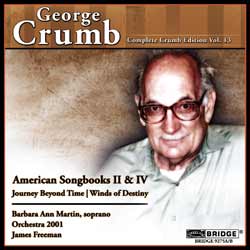 George Crumb George Crumb
A Journey Beyond Time (2003) (American Songbook II)
Winds of Destiny (2004) (American Songbook IV)
Barbara Ann Martin, soprano; Orchestra 2001; James Freeman, conductor
Complete Crumb Edition Volume 13 BRIDGE 9275A/B [82 mins]
This generous collection of Spirituals, American Civil War Songs and Folk Songs is subjected to George Crumb's familiar treatment with exotic timbres, Orchestra 2001 consisting of percussion quartet (playing more than 100 instruments) and amplified piano.
There are 9 X 2 songs and two 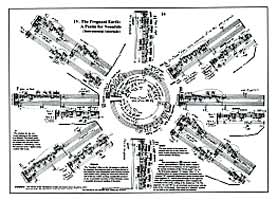 instrumental interludes, one of their scores pictured here. instrumental interludes, one of their scores pictured here.
Barbara Ann Martin is persuasive in putting them across, and the whole thing makes delectable listening, better taken in groups than straight through. But I have a problem with George Crumb, whilst having often enjoyed hearing his music. So much of it seems to be decorative and short on 'substance'...
Some years back I wrote: Timbre and sound colours are (nearly) everything for George Crumb. He has pioneered elaborate developments in live electronics - - and that feeling arose once again with this double-CD. I enjoyed it, the sounds are seductive, but we will be unlikely to return to listen through again.
And last week one of our reviewers raised similar questions about Crumb's Makrokosmos Book 1: - - Crumb’s Makrokosmos, long, disjointed and almost entirely extended techniques. I’m also not sure it’s terribly interesting music, so preoccupied is it with making clever sounds (or not so clever – would it hurt to come off the sustain pedal once in a while?). I’m afraid this performance didn’t tempt me to change my mind.
Perhaps best to sample an mp3 on line When Johnny Comes Marching Home (one of the more vigorous songs) before purchasing?
Peter Grahame Woolf
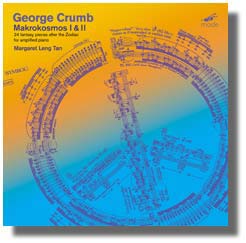
George Crumb Makrokosmos
Margaret Leng Tan (prepared piano)
mode records CD 142
Out of stock for a long time, Margaret Leng Tan's interpretation of Crumb's "Makrokosmos I & II" has been reissued on CD. The DVD version should be available again in several months.
The music of George Crumb is certainly being celebrated this year to mark his 80th birthday. And Mode Records have re-issued a recording of both books of Makrokosmos, performed by Margaret Leng Tan, originally released in 2004 for his 75th birthday.
Crumb’s incorporation of the inside of the piano into his compositions began in 1962 with Five Pieces for Piano, commissioned and first performed by David Burge. Makrokosmos I followed in 1972 (premiered by Burge in 1973) and Makrokosmos II in 1973 (premiered in 1974 by Robert Miller). Crumb acknowledges the influence of Bartok’s Mikrokosmos (in six volumes) and Debussy’s Preludes (two books of twelve pieces) - each of the two books of Makrokosmos consists of twelve pieces, grouped into 3 parts of 4 pieces each. Extra-musical influences are offered in the designation of a sign of the Zodiac to each piece as well as a descriptive title. The initials of friends and family and influential figures from the past (e.g. Brahms, Lorca) are appended to the end of each piece and the fourth of each part of four pieces has a visual ‘Symbol’ incorporating the notation to mark this structure, as well as providing Crumb himself with the opportunity to follow what could be a whim (e.g. the fourth piece in Volume II, “Twin Suns”, is two circles of notation, and “Crucifixus” of Volume I is in the shape of a cross. Indeed “Agnus Dei”, the final piece of Volume II is in the shape of the CND sign). So there is plenty of extra-musical material to trigger the pianist’s imagination and interpretation as well as the notation itself.
In an interview with Robert Shuffett (Peters Corp.1986)* Crumb answers two particular questions about his notation:
RS: Your calligraphy and careful notation have occasioned much commentary over the years. Would you comment on notation in general?
GC: I endeavour to make my own notation as simple and conventional as possible, since I want to communicate clearly and economically all the necessary information to the performer. If a score is a “book of seven seals,” then the composer is working against his own best interests. Of course notation can also be imaginative and provocative – I feel that all good music looks beautiful on the page.
RS: One visually striking aspect of your scores would be your “symbolic notations” – those representations of spirals, circular shapes, and so forth.
GC: Every composer should be permitted an occasional flight of whimsy!”
The extended sound-world of the piano called upon in order to perform Makrokosmos includes techniques such as glissandi on the strings, production of harmonics, percussion on crossbeams and the soundboard, pizzicato, the use of a wire brush, the use of a light metal chain, some paper to produce a metallic buzz, thimbles, glass tumblers, arm clusters as well as detailed use of the sustaining and sostenuto pedals, particularly in sustaining groups of notes silently and activating those particular notes through strumming or invoking an eerie resonance at the bottom of the piano. Added to these techniques are various vocal effects such as whistling (warbling and theremin-like), shouting, whispering and moaning to further extend the sound-world.
What is particularly remarkable though about Crumb’s use of the piano and the harmonic structures of his compositions, is the resultant, almost orchestral resonance of the piano. The extended techniques are not the only reason for this heightened resonance and reverberance. The extremely detailed dynamics and large dynamic range as well as the finely gauged pauses that are written into the music give the piano time to ‘breathe’ and for the harmonies and sounds to establish themselves, in their decaying resonance.
What Margaret Leng Tan achieves particularly well in her performance is the shading of the softer dynamics from p to ppp and she really draws the listener into the melodic shapes and layering of texture in this dynamic range. On the other hand, though her loud playing is very powerful and with a roundness and fullness of sound, some of the loud staccato passages could benefit from an even more incisive attack. Her incorporation of the extended techniques into the keyboard music is excellent – in particular her use of the thimbles (“Phantom Gondolier”) and glass tumblers (“Ghost Nocturne”) produce wonderful metallic sounds and spectral bending of the pitches, respectively. Her vocal contributions of words and eerie moanings are reasonably well judged and dramatic, where called for.
I wonder why she didn’t whistle? In “Voices from the ‘Corona Borealis’” because Leng Tan herself is not performing the whistled part, the two parts feel slightly less integrated in achieving the Passacaglia: very slow, with majestic calm performance instruction. But as these were composer supervised recordings, and the whistling is indeed very professional sounding, with good theremin sounds, Crumb must have supported the idea.
In this recording Margaret Leng Tan, through her virtuosic combining of playing inside and outside the piano, certainly makes the listener aware not just of isolated extended techniques, but of the whole sound-world and structure of Crumb’s fantasy pieces.
Mary Dullea
* Robert Shuffett ed. Don Gillespie, 1986: “Interview: George Crumb/Robert Shuffett” Profile of a Composer: George Crumb (New York, C. F. Peters Corporation), 34-7
Mary is completing a PhD in Performance at the University of Ulster and currently researching, commissioning, performing and recording works for the piano that incorporate the use of the inside and the outside of the instrument. [PGW]
See review of Margaret Leng Tan on DVD in John Cage
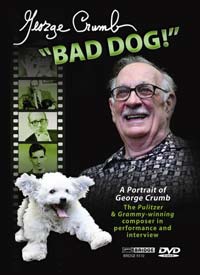
George Crumb Portrait: Bad Dog
Complete Crumb Edition Volume 14; Bridge DVD 0312 (67 mins)
This loving and lovely DVD compilation, released in time for the BBC R3's day of Total Immersion in Crumb (5 December 2009 at London's The Barbican) will endear listeners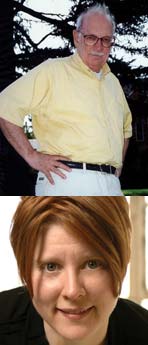 to some of George Crumb's less esoteric creations. to some of George Crumb's less esoteric creations.
It is very much a Bridge Records in-house exercise, immaculately presented, with George coming over as a straightforward "ordinary guy", which surely he isn't?
A small selection of his songs and chamber music is beautifully filmed. There are early songs with piano, and later Whitman songs welcoming soothing, delicate death (a world away from Dylan Thomas' Do not go gentle - - rage against the dying of the light). Those are presented compellingly by Tony Arnold with Robert Shannon - playing inside the instrument as well as on the keyboard; both partners ideally filmed.
David Starobin appears to have master-minded the whole thing and plays guitar alongside Crumb himself on percussion in a few of his musical portraits of some of the family dogs. Excerpts of many key works appear as incidental music to Crumb's own autobiographical commentary, and there is a delightful portrait gallery spanning George's life and career.
Recommended warmly; no-one at The Barbican this coming weekend will regret its purchase.
Peter Grahame Woolf
See also review of the Complete Crumb Edition Volume Vol 13 and my memoir of sharing a lecture platform with George Crumb in Bilbao http://www.musicalpointers.co.uk/reviews/cddvd09/CRUMBvol9.html
|



